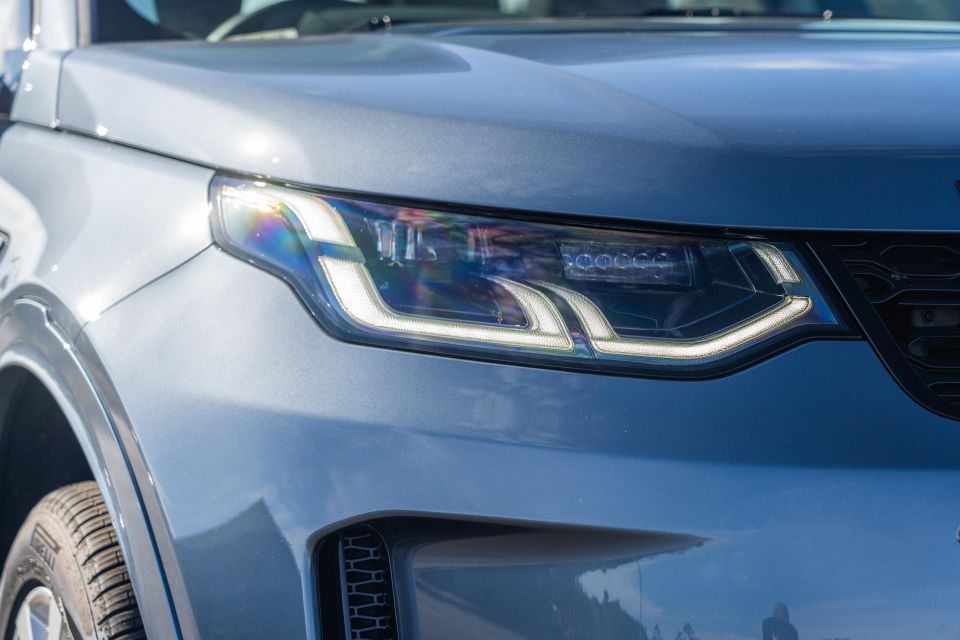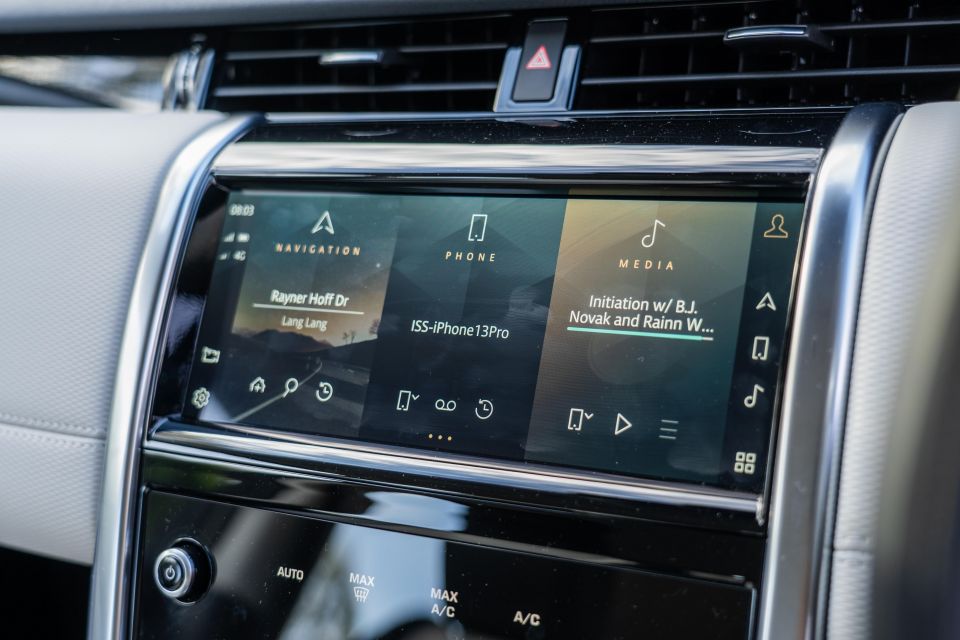

Shane O'Donoghue
2025 Nissan Ariya Nismo review: Quick drive
5 Days Ago
The Land Rover Discovery Sport is an excellent, often-overlooked seven-seat SUV that majors on practicality.



Contributor
New from
$65,700
excl. on-roads

Contributor
New from
$65,700
excl. on-roads


Contributor
New from
$65,700
excl. on-roads

Contributor
New from
$65,700
excl. on-roads
Quickly see how this car stacks up against its competition. Select any benchmark to see more details.
Where expert car reviews meet expert car buying – CarExpert gives you trusted advice, personalised service and real savings on your next new car.
Think seven-seat luxury cars need to be hulking, oversized off-roaders? The Land Rover Discovery Sport begs to differ.
It’s smaller than a BMW X3 on the outside, but the Discovery Sport manages to combine city-friendly dimensions with a spacious second row and the option of a pop-up third row of seating for children. Smart packaging is the name of the game here.
Being practical isn’t enough for the Disco Sport to succeed, though. The Land Rover badge on its bonnet means it needs to be luxurious, and the Discovery badge implies it’ll be able to hold it own off the beaten track.
Although there’s an updated version of the Disco Sport coming to Australia for 2022, it’s not clear exactly when it’ll touch down. The car you see here is a 2021 model, and will carry on for the next few months locally.
Land Rover has bitten off a lot with the Discovery Sport. Is it trying to be too many things to too many people?
The 2021 Land Rover Discovery Sport D200 R-Dynamic SE (to use its full name) is priced at $77,048 before on-road costs, although our tester was optioned to $82,468 before on-roads with a few choice additions.
It’s towards the top end of the trimmed-back Discovery Sport range, sitting below only the P250 HSE.
In the updated 2022 range, the price for the equivalent to the D200 (the D204) will kick off at $76,720 before on-road costs.
A price around the $80,000 mark puts the seven-seat Discovery Sport in line with the Mercedes-Benz GLB250 ($73,900), or five-seaters such as the BMW X3 xDrive20d ($76,900).




Standard equipment in the D200 SE includes:
Options fitted to our tester include:

That’s atop equipment standard in the P200 S and D165 S:

The Land Rover Discovery Sport has a five-star ANCAP safety rating based on testing carried out in 2014.
It scored 93 per cent for adult occupant protection, 83 per cent for child occupant protection, 69 per cent for pedestrian protection, and 82 per cent for safety assist.
All 2021 Land Rover Discovery Sport models come standard with the following safety features:

The Discovery Sport has been around since 2014, but it’s been continually updated since then. The most recent update saw the Pivi infotainment system debuted in the Defender added to the feature list, making the oldest Land Rover feel far more modern than you might expect.
With a high driving position, the Sport feels every bit a Land Rover from behind the wheel. The seating position is excellent, with a huge range of adjustment allowing tall people to get comfortable, and the seats themselves call plush armchairs to mind.
It’s a shame they’re not heated as standard, though. The black-and-cream trim on our tester looks sharp, and is a nice change from the black-on-black colour schemes prevalent in German mid-sized SUVs.

Rather than feeling like a cave, the light interior trim and massive panoramic glass roof mean the Discovery Sport is open and airy. Of all the options fitted to our tester, it’s easily the most appealing.
Jaguar Land Rover has made huge strides on the technology front recently, and the Discovery Sport hasn’t missed out. Although it misses out on the oversized display featuring in the Jaguar F-Pace or Land Rover Defender, you get a 10.0-inch display with crisp graphics and decent responses.
It doesn’t feel quite as snappy as the same system in newer models, as if the processor isn’t quite as powerful, but it still starts up as your bum hits the driver’s seat and rarely leaves you waiting for a page to load. It’s also good to look at, and the work Jaguar Land Rover has put into making menus easy to navigate on the move has paid off.


Smartphone mirroring is wired, unfortunately, and having to pay extra for wireless phone charging stings in what’s meant to be a premium product.
The driver is faced with a simple, easy-to-read digital instrument binnacle capable of showing maps, trip computer data, or your off-road information. It’s not quite on par with what Audi offers, but it’s still a premium-looking setup that calls to mind the analogue dials in older Land Rovers.
Storage spaces are everywhere in the Discovery Sport. There’s a massive space under the central armrest – it’ll swallow huge drink bottles, or a laptop you want to keep hidden – along with a space below the dash, two cupholders, and decent door pockets.

The second row is surprisingly spacious. Although it’s slightly raised compared to the front row, headroom is exceptional back there, and at six-foot-seven even I can almost sit comfortably behind myself.
There’s more toe- and legroom than you get in its mid-sized luxury rivals, and the rear air vents, 12V socket, and fold-down armrest mean it’s not short on amenities. The bench also slides, so you can prioritise legroom or boot space depending on how you’re planning to use the car.
Sliding the bench forward also frees up more space if you’re planning to use the third seating row. The Discovery Sport is technically a 5+2 instead of a seven-seater, and the rearmost row is best saved for children, but it’s more usable than you might expect.



It’s tight squeeze getting back there, but the space is suitable for children. The extra row of seats adds a level of versatility lacking in most of its rivals, although you’re better off with a full-sized Discovery (or something like a Hyundai Santa Fe) if carrying seven people is high on the priority list.
Boot space is 157 litres with the third row in place, expanding to 1179L with the third row folded and 1651L with the second and third rows folded.
Folding the seats is easy, and there are no lumps or bumps in the floor like you get in some other part-time seven seaters.

Power in the Land Rover Discovery Sport D200 comes from a 2.0-litre turbo-diesel engine with 150kW and 430Nm. It’s backed by a 48V mild-hybrid system which is capable of providing a power boost at low revs, and offers smoother start/stop that kicks in at around 10km/h.
The engine’s torque is sent to all four wheels through a nine-speed automatic transmission. Claimed fuel economy is 5.7 litres per 100km, and the fuel tank holds 65 litres of diesel.
We saw 8.5 litres per 100km on a week with a strong skew to city driving.
The engine outputs will remain unchanged for 2022 when the updated Discovery Sport touches down.

Refinement is at the core of the Discovery Sport’s appeal. The diesel engine fires quietly and settles quickly into a smooth idle, and it never sounds like a tractor on the move.
Its outputs aren’t huge on paper, but peak torque comes on tap at 1750rpm and brings with it a pleasing shove in the back. Unlike some small displacement diesel engines, the Ingenium unit in the Discovery Sport doesn’t feel strained if you push it beyond the low end of the rev range.
The engine is mated with a smooth-moving nine-speed automatic, which is pleasingly smooth and decisive.

Some eight or nine-speed transmissions can feel busy, constantly flicking from gear-to-gear, but the unit in the Discovery is content to lean on the engine’s torque on light throttle inputs, only kicking down when you really need it to.
Throw the smooth, smart 48V start/stop system into the mix and you’ve got an SUV that’s just nice to drive in the city.
Although it’s riding on 20-inch wheels, the Discovery does a good job smoothing out pimply road surfaces. It doesn’t have a sophisticated air suspension, but the fixed suspension tune is primarily focused on comfort, which is the right choice.

Occasionally it feels a bit heavy, clunking to the end of the suspension travel over sharp bumps like potholes, but the refinement is otherwise excellent.
The steering is dead on centre, but it weights up nicely as you turn the wheel. There’s a bit more arm-twirling required to park the Discovery Sport than a BMW X3, but it’s still at home in the city. With quality cameras, good visibility, and compact dimensions, you shouldn’t struggle to slot into tight parallel spots.
The ClearSight rear-view mirror is also handy if you’re using the third-row seats, or have the boot loaded all the way to the roof by showing a live feed of what’s happening behind the car. The view takes some getting used to, but it’s preferable to not being able to see at all.

Where expert car reviews meet expert car buying – CarExpert gives you trusted advice, personalised service and real savings on your next new car.
On the highway, the Sport is a relaxed and refined cruiser. Wind and road noise are well suppressed at 100km/h, even on the coarse chip highway surfaces common in Australia, and the engine ticks over barely above idle in ninth gear.
Put your foot down and it’ll happily drop one, two, three gears to get the engine singing, but it’s not quite effortless if you’re overtaking fully-loaded with passengers.
Although the more powerful P350 engine would likely be better at overtaking at highway speeds, the efficient and torquey diesel engine is perfectly suited to long stints behind the wheel. It’s the smart choice.
Land Rover’s adaptive cruise control smoothly keeps a gap to the car in front, although more modern rivals now have advanced lane-centring systems capable of taking over the steering, rather than simply intervening when you drift like the lane-keeping system in the Discovery Sport.

The Land Rover Discovery Sport is backed by a five-year, unlimited-kilometre warranty with five years of roadside assistance.
Land Rover offers a five-year, 102,000km servicing plan across the range, which costs $1950.

The Discovery Sport is a seriously clever car, and doesn’t have many direct rivals.
Unlike some of its Jaguar Land Rover siblings, it doesn’t require millions of options to make sense. In fact, it represents good value compared to the similarly-sized German crossovers that dominate the sales charts.
Yes, it’s smaller on the outside, but you wouldn’t know it based on the amount of space on offer.

Don’t let the fact its design is rooted in 2014 hold you back, because a spate of technology and engine updates mean the Disco still feels fresh.
Although you more power might be nice, you really don’t need more engine than the D200. It balances performance with fuel economy, and is well suited to life on the highway with a family in tow.
The Range Rover Evoque is sexier, and the Defender is an icon, but the Discovery Sport is arguably all the Land Rover you need.

Click the images for the full gallery
Where expert car reviews meet expert car buying – CarExpert gives you trusted advice, personalised service and real savings on your next new car.
Scott Collie is an automotive journalist based in Melbourne, Australia. Scott studied journalism at RMIT University and, after a lifelong obsession with everything automotive, started covering the car industry shortly afterwards. He has a passion for travel, and is an avid Melbourne Demons supporter.


Shane O'Donoghue
5 Days Ago


Anthony Crawford
4 Days Ago


Matt Campbell
3 Days Ago


James Wong
2 Days Ago


Max Davies
23 Hours Ago


Damion Smy
22 Hours Ago